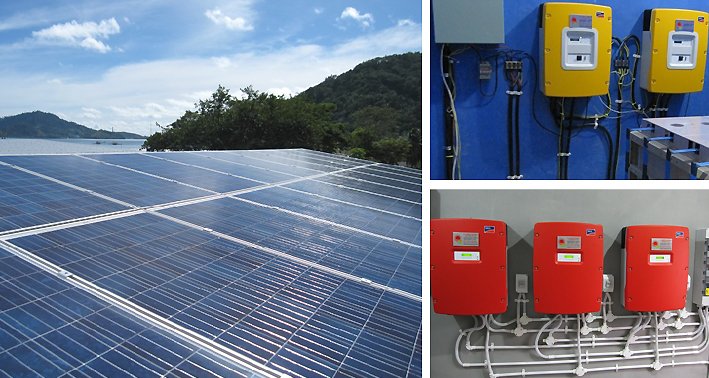Life-Saving PV: Electricity Supply for Tsunami Early Warning System

During the Christmas season of 2004, a tsunami flooded the Indonesian coast and thousands of people lost their lives. In the wake of this disaster, around 100 early warning systems were installed at sea for the early detection of tsunamis. The measuring devices may look like inconspicuous buoys but are actually extremely sensitive and highly complex.
Twenty minutes that could save lives
Sensors are used to transmit data to dry land where it is analyzed at Indonesian Maritime Authority stations. In case of a tsunami report an automatic warning is issued within five minutes, giving those affected a head start of 20 minutes to get themselves to safety – 20 minutes that could save their lives.
Unreliable utility grid
One of these measuring stations was installed near Padang on the island of Sumatra. In many parts of Indonesia and also on the island of Sumatra, the utility grid regularly experiences lengthy outages, often for several hours at a time. The electricity that is supplied is of a very poor quality with voltages under 180 volts frequently occurring, which causes many sensitive devices to simply switch off.
Environmentally friendly alternative for power outages
When the utility grid is down, data can no longer be transmitted or analyzed. This is fatal for the early warning system that is supposed to detect monstrous floodwaters in advance. Tsunami warnings cannot be registered, meaning that people cannot be warned about the impending danger. They have no time to get themselves to safety. It is possible to connect the early warning system to a diesel-powered generator to keep it running in a power outage, but there is a more environmentally friendly solution: a Sunny Island system.
The Sunny Island guarantee of an uninterruptible power supply
Since mid-2012, a PV system has helped to continuously supply the buoys and measuring systems with power. The system includes two Sunny Island units and three Sunny Mini Centrals 5000A, a Sunny WebBox and a Sunny Sensor Box. The first priority is to use the PV energy produced to bear the electrical load and thus ease the burden on the utility grid. The surplus PV energy produced is then used to charge the batteries. However, it is also possible to feed the power into the utility grid once the batteries are charged. Should the utility grid experience another power outage from this point on, the Sunny Island system takes control of the utility grid and the power supply so the measuring systems can continue uninterrupted. The system thus ensures that there is no interruption in the supply of electricity to the tsunami early warning system. And doesn’t this sound like a better solution to simply “starting up the generator”?
System put to the test during power outage at opening ceremony
The official opening of the PV system was shown on live television. The project initiators were there alongside the Indonesian Minister of Marine Affairs. There was a showdown when the Indonesian utility grid experienced a power outage during the ceremony itself. There could hardly be a better opportunity to put the system to the test − and the Sunny Island system passed with flying colors. The systems continued to run with no interruption. The Minister was also impressed with the option to log onto the system using the Sunny WebBox in order to change parameters or download data.
Other parties involved in the realization of the project included our project partner PT Suntech. One week after the official opening, PT Suntech Director Erik Sentosa received an invitation from the Ministry to discuss the possibility and logistics of equipping the other approximately 99 systems with Sunny Island systems. We hope that, with continued cooperation with our customers, we will be able to realize many more orders of this kind in the future.



Feel free to contribute!